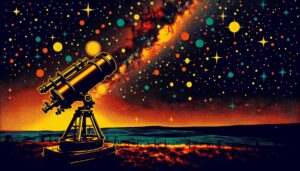This site contains affiliate links to products. I may receive a commission for purchases made through these links.
Ever gazed up at the night sky and wondered what’s beyond the stars? I’ve been there too. I’ve spent countless nights marveling at the splendor of the universe. But did you know that with the right tips, you can actually observe satellites and the International Space Station (ISS) from your backyard?
You don’t need a fancy telescope or a degree in astrophysics. All you need is a clear night, a bit of patience, and the right guidance. I’m here to provide the latter. With years of experience observing these celestial bodies, I’ve gathered a list of tips that’ll make spotting them a breeze.
Understanding Satellite Orbits
Spotting a satellite isn’t just about looking up and hoping for the best. It’s about understanding a little about how these man-made miracles move in space. It’s important to note that satellites and the ISS follow specific paths, known as orbits.
When a satellite is launched, it’s given a certain speed and direction. If done correctly, gravity will take the lead and the satellite will circle the Earth. This path is its orbit. Now, orbits aren’t all the same—depending on the purpose of the satellite, it could be in a low Earth orbit, medium Earth orbit, or geostationary orbit. For astronaut-hosting structures like the International Space Station, the low Earth orbit is the choice. This is a path less than 2,000 kilometers above the Earth’s surface – a proximity that makes it feasible for us to spot them.
| Types of Orbital Paths | Height from the Earth’s Surface |
|---|---|
| Low Earth Orbit | Up to 2,000 KM |
| Medium Earth Orbit | 2,000 KM to 35,786 KM |
| Geostationary Orbit | 35,786 KM |
The International Space Station orbits the Earth approximately every 90 minutes. The quick orbit combined with the Earth’s rotation means that observers see it pass through the sky at different times and locations. It’s worth noting that the ISS is often most visible right after sunset or just before sunrise. That’s when the balance between light and dark provides the best visual contrast.
However, you can’t just go out any night and expect to see a satellite. They’re only visible from earth when they’re in sunlight and the observer on the ground is in darkness. This reflects sunlight back down to the observer, making the satellite visible. This narrow viewing window is critical for your satellite spotting success.
With this knowledge on satellite orbits, you’re one leap closer to scanning the night skies as a budding amateur astronomer! You’ll get to impress your friends and family with your newfound capability to spot the International Space Station and other satellites—proving that astronomy can be fun and accessible to anyone.
Choosing the Right Equipment
Choosing the right equipment is an essential part in your satellite-spotting journey making the process easier and more enjoyable. Now we’ve already covered the basics of when and where to look. It’s about time we delve into what tools can help you in your newfound hobby.
First off, binoculars can be a great starting point. Not only are they more portable and easier to use than telescopes, they also help in getting a wider field of view. They make spotting satellites easier especially for beginners. Your regular binoculars should serve you well, but if you’re looking to invest, get one with 7×50 or 10×50 specifications. These numbers indicate the magnification power and lens diameter – crucial aspects to consider for clear and bright images.
In addition to binoculars, there are several apps and websites that can aid in your quest. Sky-watchers often make use of satellite tracking software like Mobile Astronomy apps and websites like Heavens-Above. These platforms provide real-time tracking data, visibility forecasts, and detailed pass predictions of various satellites and the ISS.
If you’re looking to go the extra mile, a motorized telescope might be the tool for you. It’s an upgrade – tracking celestial bodies seamlessly across the sky making the viewing experience even richer. It’s important, however, to note that telescopes are more complex to operate and can be quite the investment.
Don’t forget the role of a comfortable outdoor chair and a clear, cloudless night. The chair is for your comfort – satellite spotting can be a waiting game. A clear sky, on the other hand, is a non-negotiable factor – the clearer the sky, the better the viewing experience.
Do consider these tools and tips as you embark on your satellite-spotting endeavours. Remember, the aim is to make it an enjoyable and fulfilling experience. There’s much to learn and see beyond our planet.
Finding the Best Viewing Locations
Next on the agenda is all about location, location, location. You’ve got your high-quality 7×50 or 10×50 binoculars on hand and you’re prepared to track satellites using your favorite software or website like Heavens-Above. But where do you go to actually see these marvels whizzing past in the night sky? Sit back in your comfy chair (that’s important, remember!) and let’s explore some key factors in selecting the perfect viewing spot.
Light pollution is a sky watcher’s nemesis. It dramatically reduces the number of celestial bodies you can see with the naked eye. The prime spot to set up your observation post is away from the lights of urban sprawl. Wide open spaces with minimal artificial light such as rural countryside, or mountain tops are your best bet.
To help you find such a location, there are numerous “dark sky” maps available online. Websites like the International Dark-Sky Association can guide you toward areas with minimal light pollution. Certain smartphone apps like Dark Sky Finder also serve the same purpose.
Another factor is your geographical position. The International Space Station (ISS) for instance, is visible from different places on Earth at different times. It’s essential that you familiarize yourself with its patterns. Good news: there are websites and apps that can help you with this too. One reliable source is NASA’s Spot The Station. It’s a fantastic service that provides precise sighting opportunities for your specific location.
| Source | Function |
|---|---|
| International Dark-Sky Association | Finding dark skies |
| Dark Sky Finder | Locating minimal light pollution areas |
| NASA’s Spot The Station | Identifying ISS sighting opportunities |
Finally, anticipate the weather. Even the darkest, most secluded spot won’t do you any good if you can’t see through the clouds. Regularly check weather forecasts for clear nights and low wind. The Weather Channel or AccuWeather are useful resources for this.
So, you have your equipment, your software, your comfy chair. You’ve found a great dark sky site, monitored the ISS schedules, and kept an eye on the weather. Now, there’s nothing to stop you from venturing out into the night and staring into the vast expanse of the cosmos. The satellites are waiting.
Timing Your Observation
The heart of successful satellite spotting lies in excellent planning, and a crucial part of this is timing. No matter how perfect your equipment or your viewing location, without precise timing, you’re likely to miss out.
Satellites like the International Space Station (ISS) follow predictable orbits. That is, they pass over at regular intervals with a fair degree of accuracy. To increase your chances of spotting a satellite, you need to know exactly when it’s going to be overhead. Websites such as Heavens-Above and NASA’s Spot The Station can provide detailed pass predictions. These sites give you time, direction, and the angle at which the ISS or other satellites will pass over your location.
There’s also a right time of day for satellite spotting. While you might think night is the best time, that’s not always the case. The ideal time locally is during dusk or dawn when the sky isn’t completely dark. The reason behind this is simple – if the sky is pitch black, then the satellite would be in the Earth’s shadow and not visible. But during dusk or dawn, you’re likely to see the satellite illuminated by the sun’s light, making it easier to spot. The exact timing depends on your specific geographical location and the timing of the sunrise and sunset.
Consider the ISS, for instance. The ISS orbits around the Earth approximately every 90 minutes. However, not every pass over your location will be visible. The ISS needs to be illuminated by sunlight, which will reflect off its solar panels and make it visible to us on the ground. The ISS is most visible during twilight – when the sky is darkening after sunset, or lightening before sunrise. During this time, you are in darkness, but the ISS overhead is still bathed in sunlight.
Weather, of course, is another significant factor. Clear skies improve visibility, while overcast conditions or fog can make satellite spotting nearly impossible. Always ensure you scope out the weather situation, and if it’s not cooperating, don’t be disheartened – there’s always another pass.
Identifying Satellites and the ISS
As we’ve discussed, timing is a crucial factor in spotting satellites. But how do you actually identify these space objects? It’s not as intimidating as one may think. Though not all satellites are visible to the naked eye, there are still some that can easily be spotted. Additionally, the ISS is one of the most identifiable factors in the night sky, rivaled only by the Moon and our neighboring planet, Venus.
When it comes to distinguishing satellites, one key tip to remember is that they move in predictable patterns crossing the sky in a matter of minutes. Unlike airplanes, satellites do not have flashing lights and they won’t change directions. Therefore, if it’s not flashing and is moving in a steady straight line, it’s likely to be a satellite.
Spotting the ISS is a noteworthy experience. It often appears as a bright, fast-moving point of light. Furthermore, we can consider it as the third brightest object in the sky after the Sun and the Moon. Despite numerous stars and planets surrounding it, the ISS outshines them in its brilliance and its constant movement.
While patience and practice are required to master satellite and ISS spotting, there are also some tools and techniques that can provide assistance. For instance, there are numerous mobile apps available, like ISS Detector and Satellite Tracker, which give real-time updates and alerts for satellite and ISS sightings. These apps also offer invaluable information such as the satellite’s current location and its predicted path across the sky.
Capturing Photos and Videos
As an experienced stargazer, I’ve found that capturing photos and videos of satellites, notably the ISS, isn’t as daunting as it appears. You don’t need high-end or professional equipment.
Use your smartphone or a standard digital camera for starters. Many modern smartphones have impressive camera capabilities that allow you to take decent photos under low light conditions. However, for better image quality, consider investing in a digital single-lens reflex (DSLR) camera.
Secondly, a sturdy tripod is essential. It helps steady your camera, avoiding blurred shots. Set your camera on a slow shutter speed. This enables the camera to gather more light to capture the fast-moving ISS. I’d recommend a shutter speed of at least 15-30 seconds.
Obtain the Right Apps
I like to use satellite tracking apps like ISS Detector or Satellite Tracker. The apps not only assist in spotting the ISS or satellites, but they also have features that aid in photography. They provide real-time updates on the current location, predicted path, and precise passing time. This helps in pre-planning your shots.
Play with the Exposure Settings
One crucial aspect of astrophotography is knowing how to set the exposure correctly. You’ll want to go for a low ISO setting to avoid noise and grain in your image. Also, an aperture of around f/2.8 to f/4.5 works well in capturing the illuminated path of the ISS across the sky.
Experiment
Even for a seasoned enthusiast like me, capturing the perfect satellite image or video is often a matter of trial and error. Experiment with different settings and try various compositions. Over time, I’ve found that the best technique is to continue shooting, discover what works, and what doesn’t. I assure you that the results are worth the journey!
Remember, shooting in manual mode provides greater control over image output. However, if you’re feeling overwhelmed, don’t be disheartened. Start with the basics, learn, and incrementally master the additional features.
Sharing Your Observations with the Community
After capturing the celestial spectacle of satellites and the International Space Station, you might be wondering, “What’s next?” It’s time to share your observations and findings with the wider community. This act not only validates your hunting capabilities but it also conveys useful real-time data to fellow satellite watchers and photographers.
First stop? Social media platforms. Sharing your findings on channels such as Facebook, Twitter, and Instagram is an interactive and effective way to alert and engage your friends and followers. For a more specialized audience, online forums and communities like Reddit’s r/space or websites such as Cloudy Nights can give you the space enthusiasts’ attention and constructive feedback that you’re after.
Next, consider submitting your stellar shots to astronomy websites and societies. The American Astronomical Society (AAS) and the Astronomical League often seek satellite and night-sky photographs from amateur observers. These organizations flaunt extensive reach and credibility, giving your snapshots the potential to be seen and appreciated by a vast number of like-minded individuals.
In addition, creating a personal blog or YouTube channel showcasing your satellite observations and image capturing techniques can also be beneficial. Here you can share your endeavors, findings, techniques, and even your learning experiences. Remember – growth is a constant process. So, don’t hesitate to share both your victories and hurdles; it’s all a part of the beautiful journey called ‘Space Observation’.
To facilitate the sharing process use handy tools like Canva for creating engaging posts and InShot for editing and portraying your videos effectively.
A word of caution though – make sure to maintain digital citizenship. While sharing, respect others’ work, avoid plagiarism, and always acknowledge your source where required. This way, you’ll not only share but also contribute to the global space-watching community in a significant and meaningful way.
Conclusion
So, there you have it. Sharing your satellite and International Space Station observations can be a rewarding experience. It’s not just about the thrill of spotting these celestial bodies, but also the joy of engaging with a community that shares your passion. Social media platforms, online forums, and astronomy websites offer excellent avenues to share your findings. Starting a personal blog or YouTube channel can further enhance your engagement.
Remember, tools like Canva and InShot can help make your posts and videos more appealing. But most importantly, let’s not forget the golden rule – respect other’s work and steer clear of plagiarism. With these tips, I’m confident you’ll make the most of your stargazing adventures.







